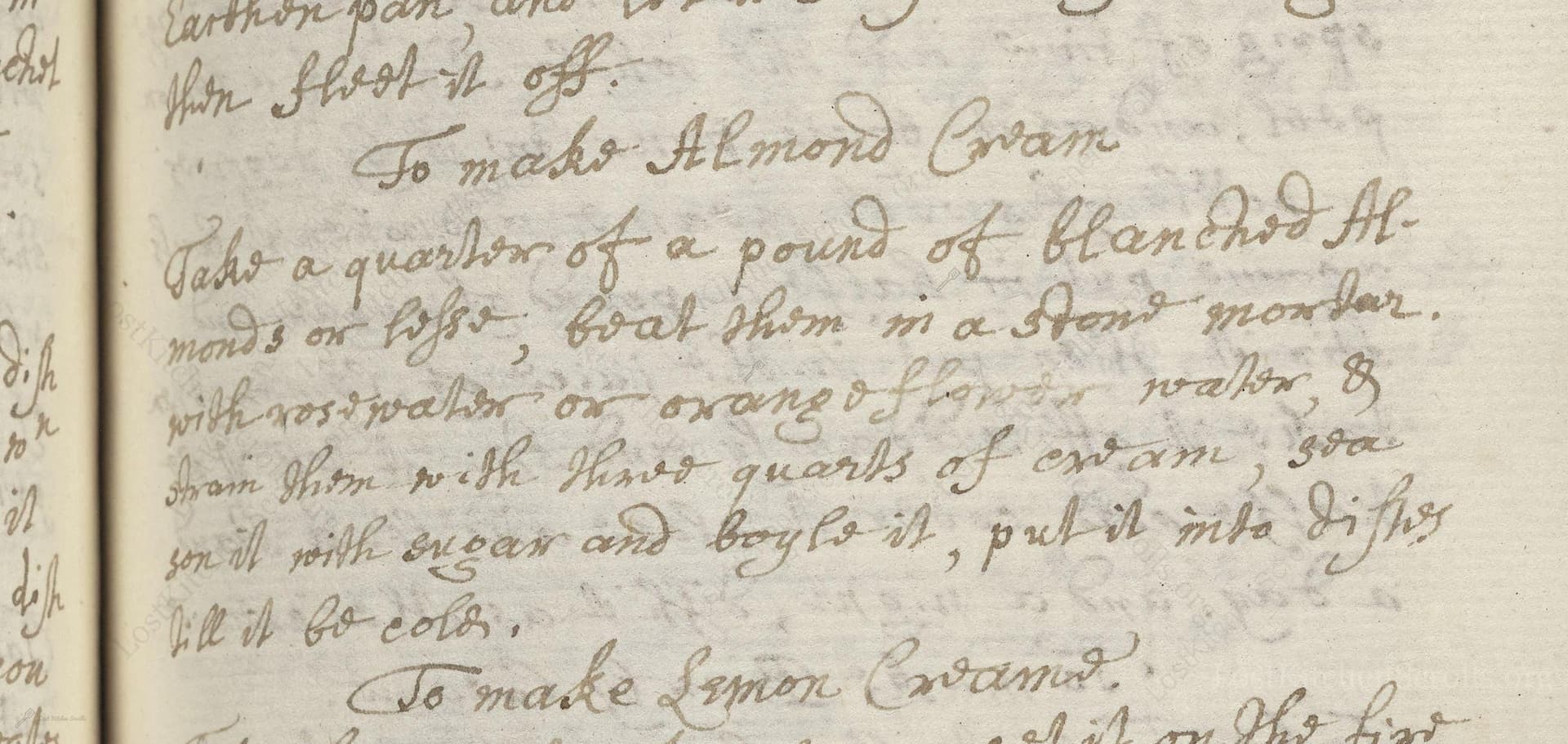To Make Almond Cream
From the treasured pages of Manuscript cookery book
Unknown Author

To Make Almond Cream
"Take a quarter of a pound of blanched Almonds or lesse, beat them in a stone mortar with rosewater or orangeflower water & strain them with three quarts of cream. sweeten it with sugar and boyle it, put it into dishes till it be cold."
Note on the Original Text
The recipe is written in brisk imperative style, common in early modern English cookery manuscripts, with little punctuation and compact phrasing. Quantities and times are often vague, as cooks were expected to rely on experience and judgment rather than precise measurements. Spellings like 'boyle' for 'boil', 'lesse' for 'less,' and the run-on directions reflect the orthography and syntax of the era, before English spelling was standardized.

Title
Manuscript cookery book (1680)
You can also click the book image above to peruse the original tome
Writer
Unknown
Era
1680
Publisher
Unknown
Background
A tantalizing window into the kitchens of yesteryear, this late-17th century collection presents recipes and culinary wisdom meant to delight and surprise even the most discerning of historical gourmands.
Kindly made available by
Folger Shakespeare Library
This recipe originates from a late 17th-century English manuscript, dating roughly between 1675 and 1686. During this period, English kitchens were beginning to experiment with imported ingredients such as almonds and fragrant waters, which showcased influences from continental Europe and the Islamic world. The combination of rich dairy, fragrant floral waters, and ground nuts was highly fashionable among the elite, reflective of both wealth and a growing culinary cosmopolitanism. Almond creams like this would have been served chilled as delicate desserts at sumptuous banquets, offering a luxurious close to a meal.

In the late 1600s, cooks would use a stone mortar and pestle to grind the almonds into a paste, achieving a fine texture. A coarse linen cloth or fine sieve was used to strain the almond cream, and all boiling occurred over an open hearth with heavy-bottomed pots and pans. Cream would be stored in ceramic or pewter dishes to cool, as refrigeration did not exist and cooling was achieved simply by letting dishes sit in a cool part of the kitchen or cellar.
Prep Time
20 mins
Cook Time
15 mins
Servings
12
We've done our best to adapt this historical recipe for modern kitchens, but some details may still need refinement. We warmly welcome feedback from fellow cooks and culinary historians — your insights support the entire community!
Ingredients
- 4 ounces blanched almonds (about 1/4 pound)
- 3 quarts fresh cream (double or heavy cream as modern substitute)
- 1–2 tablespoons rosewater or orange flower water (15–30 mL)
- 1/2 cup granulated sugar (to taste)
Instructions
- Begin by taking 4 ounces of blanched almonds and grind them finely using a mortar and pestle, moistening them occasionally with a splash of rosewater or orange flower water (about 1–2 tablespoons in total).
- Once you have a fine almond paste, stir it into 3 quarts of fresh cream (you may use double or heavy cream for richness).
- Strain this mixture through a fine seive or cheesecloth to extract as much almond flavor as possible, discarding the solids.
- Sweeten the infused cream with sugar to taste, approximately 1/2 cup, and slowly bring to a gentle boil on the stove, stirring constantly to prevent scorching.
- Once heated and slightly thickened, poor into serving dishes and cool completely before serving.
Estimated Calories
440 per serving
Cooking Estimates
Preparing and grinding the almonds takes about 20 minutes. Cooking and infusing the cream with the almond flavor takes another 15 minutes. The recipe makes about 12 servings, and each contains about 440 calories.
As noted above, we have made our best effort to translate and adapt this historical recipe for modern kitchens, taking into account ingredients nowadays, cooking techniques, measurements, and so on. However, historical recipes often contain assumptions that require interpretation.
We'd love for anyone to help improve these adaptations. Community contributions are highly welcome. If you have suggestions, corrections, or cooking tips based on your experience with this recipe, please share them below.
Join the Discussion
Rate This Recipe
Dietary Preference
Main Ingredients
Culinary Technique
Occasions

Den Bockfisch In Einer Fleisch Suppen Zu Kochen
This recipe hails from a German manuscript cookbook compiled in 1696, a time whe...

Die Grieß Nudlen Zumachen
This recipe comes from a rather mysterious manuscript cookbook, penned anonymous...

Ein Boudain
This recipe comes from an anonymous German-language manuscript cookbook from 169...

Ein Gesaltzen Citroni
This recipe, dating from 1696, comes from an extensive anonymous German cookbook...
Browse our complete collection of time-honored recipes



